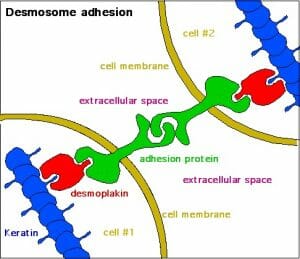Desmosomes Definition
Desmosomes are a type of anchoring junction in animal tissues that connect adjacent cells. Anchoring junctions are button-like spots found all around cells that bind adjacent cells together. Desmosomes have intermediate filaments in the cells underneath that help anchor the junction, while the other type of anchoring junction, an adherens junction, is anchored by microfilaments. Intermediate filaments and microfilaments are two different components of a cell’s cytoskeleton.
Function of Desmosomes
The function of desmosomes is to adhere cells together. They are found in high numbers in tissues that are subject to a lot of mechanical forces. For example, many are found in the epidermis, which is the outer layer of skin, and the myocardium, which is muscle tissue in the heart. They are also found in between squamous epithelial cells, which form the lining of body parts like the heart, blood vessels, air sacs of the lungs, and esophagus.
Desmosome Structure
There are three components in desmosomal adhesion: the intermediate filaments inside the cell, the bond between intermediate filaments and desmosomal adhesion molecules, and the bond provided by the desmosomal adhesion molecules. The intermediate filaments and their link to the desmosomal adhesion molecules are both located inside the cell, while the bonds of the desmosomal adhesion molecules themselves are on the outside of the cell. Specifically, desmoglein and desmocollin are the two proteins that bind cells at desmosomes. They are transmembrane proteins and are both members of the cadherin family of proteins. All three components of desmosomal adhesion are necessary for desmosomes to properly function in binding adjacent cells together, so if one of the components fails, the desmosomes cannot bind cells properly.

This diagram depicts how cells adhere at desmosomes.
Disorders of Faulty Desmosome Functioning
Epidermolysis Bullosa Simplex
Epidermolysis bullosa simplex (EB) is a genetic condition that causes skin to be fragile and blister extremely easily. This disorder is caused by a mutation in the gene coding keratin proteins found in the intermediate filaments. The intermediate filaments do not form properly in the epidermis, so skin cells are not bound together properly and can easily break apart. It occurs in 1 in 30,000 to 50,000 people, with some cases being more severe than others. In mild cases, blistering is usually confined to the hands and feet, areas that experience a lot of mechanical stress. In more severe cases, widespread blistering can occur all over the body. There is no cure for EB, but blistering can be prevented by strategies like wearing loose clothing, keeping cool, and avoiding walking long distances.
Ectodermal Dysplasia/Skin Fragility Syndrome
Ectodermal dysplasia/skin fragility syndrome is a rare genetic disease caused by a mutation that leads to intermediate filament detachment from desmosomes. It causes frequent blistering, abnormal hair, tooth, and nail growth, frequent infections, and defective sweating. Sometimes, affected individuals must use a wheelchair due to extreme blistering on the soles of their feet. Very few cases of this disorder have been reported.
Pemphigus
Pemphigus is a rare skin disorder caused by faulty desmosomal adhesive binding. In a person with pemphigus, the body produces antibodies against the protein desmoglein. When desmoglein is attacked by the immune system, the binding between cells breaks. It causes blisters and sores on the skin and mucous membranes. There are two main types of phemphigus, pemphigus vulgaris and pemphigus foliaceus. Pemphigus vulgaris occurs around the mouth and is painful, while pemphigus foliaceus occurs on skin and causes itchiness. Skin lesions caused by pemphigus can lead to fatal infections, so treatment is extremely important. Pemphigus can be treated via steroids and immunosuppressant drugs, among other medications.
Arrhythmogenic right ventricular dysplasia
Arrhythmogenic right ventricular dysplasia (ARVD), also called arrhythmogenic right ventricular cardiomyopathy, is an inherited heart condition caused by desmosome defects in heart muscle cells. It is characterized by arrhythmia in the right ventricle of the heart. Symptoms include heart palpitations, fainting, and shortness of breath. One in 5000 people have ARVD. It is treated by implantation of a small defibrillator. ARVD is progressive and can lead to right ventricular failure; the left ventricle can also be weakened. It can cause sudden cardiac death in athletes, and accounts for 1/5 of all sudden cardiac deaths in people under 35.
Related Biology Terms
- Anchoring junction – A type of cell junction in which cells are connected by a mass of proteins.
- Adherens junction – A type of anchoring junction that adheres cells via microfilaments.
- Cadherin – A type of protein that adheres adjacent cells.
- Intermediate filaments – Components of a cell’s cytoskeleton that are bigger than microtubules but smaller than microfilaments.
Quiz
1. Which component of the cytoskeleton is involved in desmosomal adhesion?
A. Microfilaments
B. Intermediate filaments
C. Microtubules
2. Which component of desmosomal adhesion is absolutely necessary in order to bind adjacent cells?
A. The intermediate filaments
B. The bond between intermediate filaments and desmosomal adhesion molecules
C. The bond that desmosomal adhesion molecules have to each other
D. All of the above
3. Which disorder described in the article has two main types and is characterized by blisters and sores on the surface of the skin and mucous membranes?
A. Epidermolysis bullosa simplex
B. Ectodermal Dysplasia/Skin Fragility Syndrome
C. Pemphigus
D. Arrhythmogenic right ventricular dysplasia
